Abstract
A series of 9%CeOx–MnOx/TiO2–GO nanocomposites with different molar ratios of Ce/Mn were synthesized by the sol-gel and ultrasonic impregnation methods and characterized by field emission scanning electron microscope (FESEM), high resolution transmission electron microscopy (HRTEM), N2 adsorption (BET) analysis, X-ray photoelectron spectroscopy (XPS), and Fourier transform infrared spectroscopy (FT–IR). The results showed that various valences of Ce and Mn oxides were uniformly distributed on the surface of TiO2–GO multilayered supports. The coexistence of various valences of Ce and Mn oxides can improve the redox performance of the catalyst. With the introduction of Ce, the amount of MnO2 and non-stoichiometric MnOx/Mn, the total oxygen and chemisorbed oxygen content, and the electron transfer ability of the catalyst increased significantly. When the molar ratio of Ce/Mn was 0.3, the catalysts exhibited high selective catalytic reduction activity (more than 99% at 180 °C) and N2 selectivity. The presence of hydrophilic groups on the surface of the GO was considered as the critical factor influencing the H2O resistance of the catalyst. Due to the pre-sulfuring process of GO, serious sulfation of the active component can be prevented, and the catalyst exhibited excellent SO2 resistance.
1. Introduction
Removal of the nitrogen oxides (NOx) emitted from the combustion of fossil fuels has attracted much more attention worldwide because NOx can cause acid rain, photochemical smog, greenhouse effects, and damage to human health [1,2]. Currently, low-temperature selective catalytic reduction (SCR) has been considered as a reasonable and effective strategy to decrease the NOx levels in gaseous emissions [3,4,5,6].
For their relatively high activities for low-temperature NH3-SCR, Mn-based catalysts have attracted increasing attention. It has been shown that the reaction activity of manganese oxide is affected by several factors, such as Mn oxidation state, crystallinity, specific surface area, and morphology [7,8,9,10]. However, the selective catalytic reduction (SCR) activity of MnOx is not as high as expected, and the resistance of MnOx to SO2 and/or H2O is relatively poor, so some other metal oxides are often added, such as CeOx [11], FeOx [12], NbOx [13], SnOx [14], and ZrOx [15]. Compared with other metal oxides, CeOx is considered more effective. The redox shift between Ce4+ and Ce3+ will result in the increase in the oxygen storage capability of MnOx and the oxygen migration speed, which are important for the reaction activity of the catalyst [16,17]. Additionally, it has also been shown that when CeOx is added into MnOx, the Mn ions will enter the CeO2 lattice to form a nanoscale solid solution [18]. On the other hand, the addition of CeO2 can improve the distribution status of MnOx on the surface of the support and enhance the oxidation of NO to NO2, producing more absorbed NO3− on the catalyst surface, which is then reduced into N2 by NH3. These behaviors account for the promoting effect of CeO2 on the SCR activity [19]. Qi et al. prepared a CeO2–MnOx catalyst and showed that the addition of Mn into the Ce lattice significantly improves NO conversion; however, increasing the Mn content beyond a certain point degrades this conversion [20,21]. It has also been proven that the introduction of CeOx is beneficial to the SO2 resistance of the catalysts. Jin et al. reported that the introduction of Ce can not only lessen the sulfation of MnOx, but also reduce thermal stabilities of the sulfate species covered on the catalyst surface [22]. Wu et al. prepared Mn/TiO2 and ceria-modified Mn/TiO2 catalysts by the sol-gel method, and the results showed that the doping of ceria can prevent the formation of Ti(SO4)2 and Mn(SO4)x, and the depositions of (NH4)2SO4 and NH4HSO4 can also be significantly inhibited [23].
Carbon materials, such as activated carbon (AC), AC fiber (ACF), carbon nanotubes (CNTs), ordered mesoporous carbons, graphene, and graphene oxide (GO), are considered as ideal supports of catalysts for their large specific surface areas and relatively high chemical stabilities [24,25,26,27,28,29,30,31,32]. GO, as the derivative of graphene, consists of a hexagonal ring-based carbon network with both sp2 and sp3 hybridized carbon atoms [33], both sides are accessible [34], and GO is a sheet-shaped material with large specific surface area up to 400–1500 m2/g [35,36]. It has also been reported that the existence of extensive reactive oxygen functional groups [37,38,39], holes [40], carbon vacancies, and defects on the surface of GO can introduce chemically-active sites during catalysis [41]. It has been suggested that GO could be an ideal support for the growth of functional nanoparticles and would render them electrically conductive, highly dispersive, and catalytically active [35].
We recently found that MnOx/TiO2–GO catalysts exhibited high NH3–SCR activity and N2 selectivity at low temperature. The results showed that the 9%MnOx/TiO2–0.8%GO catalyst had the highest activity at low temperature [42]. In order to improve the SCR activity further, a certain amount of CeOx was added to the MnOx/TiO2–GO catalyst in this work, which was represented as 9%Ce–Mn/TiO2–0.8%GO. The composite catalysts were characterized by field emission scanning electron microscope (FESEM), high resolution transmission electron microscopy (HRTEM), N2 adsorption (BET) analysis, X–ray photoelectron spectroscopy (XPS), and Fourier transform infrared spectroscopy (FT–IR), temperature-programmed desorption of NH3(NH3–TPD), and temperature-programmed reduction of H2(H2–TPR). The focus of the work was to identify the effect of the introduction of Ce and the synergistic effect of Ce, Mn, and GO on the catalytic performance of the nanocomposites. The influences of the catalyst SCR activity by H2O and SO2 were also determined.
2. Results and Discussion
2.1. SCR Activity of Different Molar Ratios of Ce/Mn
The SCR activities of 9%Ce–Mn/TiO2–0.8%GO with different molar ratios of Ce/Mn at low temperature are shown in Figure 1.
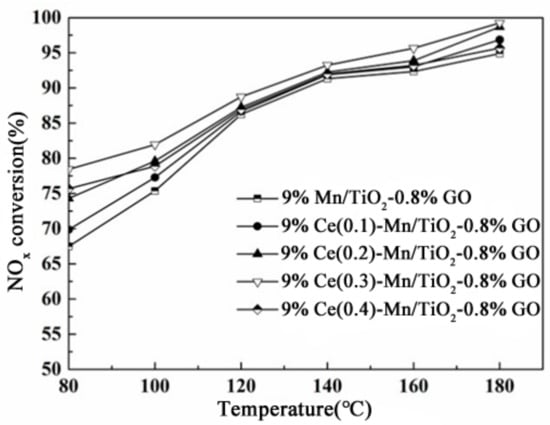
Figure 1.
Low-temperature catalytic activities of MnOx/TiO2–0.8%GO and CeOx–MnOx/TiO2–0.8%GO catalysts.
From Figure 1, it can be found that the NOx conversion efficiencies of all catalysts increased with the reaction temperature and, with the addition of Ce, the 9%Ce–Mn/TiO2–0.8%GO catalysts exhibited higher SCR activity than that of 9%Mn/TiO2–0.8%GO. When the Ce/Mn ratio was below 0.4, the NOx conversion of 9%Ce–Mn/TiO2–0.8%GO catalysts increased with the Ce/Mn ratio. When the ratio was 0.3, the catalytic activity had the highest value of 99% at 180 °C. That meant that the introduction of a certain amount of Ce was beneficial to the increase of reaction activity of the catalyst, which will be explained by the following HRTEM and XPS analyses. It can also be observed that when the Ce/Mn ratio was as high as 0.4, the efficiency decreased. Similar results have been obtained in our previous work [43]. This may be attributed to the aggregation of active components on the surface of the support, which will be interpreted by the following BET analysis.
N2 selectivity and N2O formation of the catalysts with the reaction temperature are shown in Figure 2. It can be found that high N2 selectivity (>97%) and a small amount of N2O formation (less than 10 ppm) exists over all of the catalysts. However, the addition of Ce and the increase of temperature had negative effect on the N2 selectivity and N2O formation of the catalysts. With the increase of the reaction temperature, much more NH3, which acted as a reducing agent in the SCR reaction, will be oxidized to generate N2O. As a result, the N2 selectivity of the catalyst decreased with temperature. It has also been proven by Liu et al. that with the increase the ratio of Ce/Mn, much more N2O will be generated. According to the definition of N2 selectivity in Equation (2) mentioned below, the N2 selectivity was decreased [16]. For practical application, the catalyst with reasonable molar ratios of Ce/Mn (0.3) can be chosen as a candidate for its high SCR activity, N2 selectivity, and trace amount of N2O formation at low temperature.
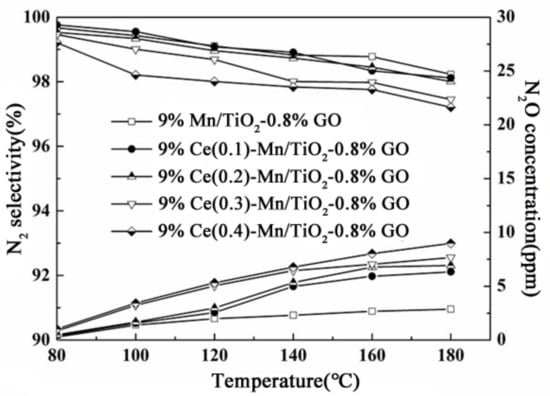
Figure 2.
N2 selectivity and N2O formation over MnOx/TiO2–0.8%GO and CeOx–MnOx/TiO2–0.8%GO catalysts.
2.2. Characterization of the Catalysts
2.2.1. FESEM of the Supports
FESEM images of GO and TiO2–0.8%GO supports are shown in Figure 3a,b, respectively. From Figure 3a, the multilayer morphology of GO sheets can be observed clearly, which was considered as an ideal structure to provide a high specific surface area and prevent the aggregation of metal oxides on its surface. In Figure 3b, some white anatase TiO2 particles could be observed distributed on the GO surface, and there was an accumulation of them in some areas of the GO, which will be proven by the following HRTEM analysis. It has been identified that the TiO2–0.8%GO is an ideal support for catalysts [42].
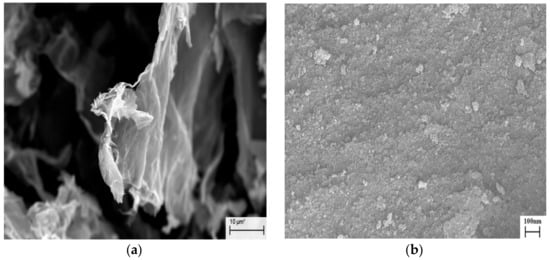
Figure 3.
FESEM images of (a) GO and (b) TiO2–0.8%GO.
2.2.2. HRTEM of the Catalyst
The microstructure of 9%Ce(0.3)–Mn/TiO2–0.8%GO was characterized by TEM and HRTEM, as shown in Figure 4b, respectively. In Figure 4a, the sheet-like morphology of GO can be observed, and the TiO2, MnOx, and CeOx nanoparticles were dispersed randomly on the surface of the GO sheets. Though there was a little aggregation in some area of GO, it was not serious, which may be attributed to the introduction of GO. The corresponding HRTEM image of the catalyst was shown in Figure 4b. The observed spacing between the lattice planes of the catalyst was around 0.218, 0.352, 0.384, 0.420, 0.436, and 0.610 nm, corresponding to the (510) crystallographic planes of Ce2O3, the (101) crystallographic planes of anatase TiO2, the (211) crystallographic planes of Mn2O3, the (110) crystallographic planes of CeO2, the (021) crystallographic planes of Mn3O4, and the (001) crystallographic planes of GO, respectively. The well-distributed status of active components on the surface of the support [44] and the coexistence of multivalent metal oxides [43] can improve the selective catalytic reduction abilities of the composite catalysts at low temperature.
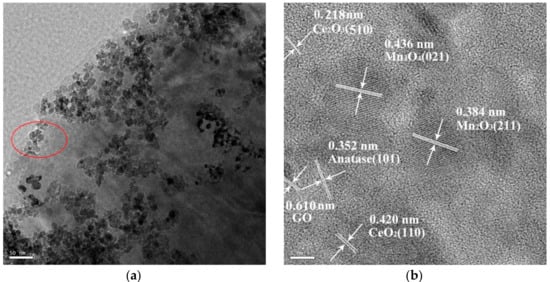
Figure 4.
TEM (a) and HRTEM image (b) of 9%Ce(0.3)–Mn/TiO2–0.8%GO.
2.2.3. BET Surface Areas and Pore Size Distributions
The specific surface area, pore volume, and pore size of the CeOx−MnOx/TiO2–GO and MnOx/TiO2–GO are summarized in Table 1. It can be found that the addition of CeOx to the 9%Mn/TiO2–0.8%GO had a negative effect on the specific surface area and the porous structure parameters, which has also been proven by some other analogous research [19,45,46]. When the ratio was no more than 0.3, this tendency was not very obvious, but when the Ce/Mn molar ratio reached 0.4, the specific surface area and total pore volume of the catalysts decreased significantly. For the SCR activity of 9%Ce(0.4)–Mn/TiO2–0.8%, GO was lower than that of 9%Ce(0.3)–Mn/TiO2–0.8%GO, and it can be concluded that the specific surface area and total pore volume of the catalyst had an effect on the reaction activity of the catalyst. On the other hand, though the 9%Ce(0.3)–Mn/TiO2–0.8%GO had the highest activity among the catalysts, its specific area and pore volume did not have the highest value. This meant that the activity of the catalyst was affected by not only the specific surface area and total pore volume of the catalyst, but also some other important factors, which will be revealed by the following character results.

Table 1.
Structural parameters of CeOx−MnOx/TiO2–0.8%GO catalysts.
2.2.4. XPS Characterization
The atomic concentration and element chemical state on the surface of the 9%Mn/TiO20.8%GO and 9%Ce(0.3)Mn/TiO2–0.8%GO catalysts were further investigated by XPS. Figure 5a–c illustrate the obtained XPS spectra for Mn2p, Ce3d, and O1s, respectively, and the corresponding surface atomic concentrations and relative percentages of various oxidation states are summarized in Table 2.

Figure 5.
XPS spectra of Mn 2p (a), Ce 3d (b), and O 1s (c) for 9%Mn/TiO2–0.8%GO and 9%Ce(0.3)–Mn/TiO2–0.8%GO catalysts.

Table 2.
Structural parameters of CeOx−MnOx/TiO2–0.8%GO catalysts.
From Figure 5a, it can be found that the Mn 2p3/2 spectra for the 9%Mn/TiO2–0.8%GO and 9%Ce(0.3)–Mn/TiO2–0.8%GO catalysts can both be divided into three characteristic peaks attributed to MnO (640.9 eV), Mn2O3 (642.2 eV), and MnO2 (644.6 eV). However, the bonding energy of the Mn 2p3/2 spectra in 9%Ce(0.3)–Mn/TiO2–0.8%GO showed a slight offset toward the high value, which indicated that the electron transferability could be improved by addition of Ce [43]. The Mn 2p1/2 spectra of 9%Ce(0.3)–Mn/TiO2–0.8%GO catalyst exhibited two characteristic peaks at 653.0 eV (MnOx/Mn) and 654.1 eV (MnO2), but for the Mn 2p1/2 spectra of the 9%Mn/TiO2–0.8%GO catalyst, there was only one peak corresponding to the existence of non-stoichiometric MnOx/Mn. The contents of Mn with different vacancies in Table 2 were achieved by calculating the percentage of the corresponding peak area. According to Table 2, the content of MnO2 for 9%Ce(0.3)–Mn/TiO2–0.8%GO was higher than that of 9%Mn/TiO2–0.8%GO. This meant the introduction of Ce can increase the content of MnO2 in the catalyst. It has been reported that MnO2 had the highest low-temperature NH3–SCR activity among various manganese oxides [47]. In addition, from Table 2, it is also shown that, compared with 9%Mn/TiO2–0.8%GO catalyst, 9%Ce(0.3)–Mn/TiO2–0.8%GO nanocomposite had a higher content of the non-stoichiometric MnOx/Mn, which has been demonstrated to be beneficial to the redox reaction of the catalyst and further increase the removal rate of NOx in the SCR reaction [48]. Thus, with the addition of Ce, the content of MnO2 and non-stoichiometric MnOx/Mn will be increased, which results in the improvement of the catalytic activity of the nanocomposite catalyst [49,50,51].
The Ce3d spectrum of the 9%Ce(0.3)–Mn/TiO2–0.8%GO catalyst, which is composed of the Ce 3d3/2 and Ce 3d5/2 spectra, are presented in Figure 5b. The Ce 3dp5/2 spectra can be divided into four characteristic peaks at 882.5 eV (Ce4+), 885.8 eV (Ce3+), 888.8 eV (Ce3+), and 898.3 eV (Ce2+), respectively, while the Ce3d3/2 spectra can also be divided into four characteristic peaks at 901.4 eV (Ce4+), 903.8 eV (Ce3+), 907.3 eV (Ce4+), and 916.8 eV (Ce4+), respectively. The coexistence of Ce2+, Ce3+, and Ce4+ can create a charge imbalance, vacancies, and unsaturated chemical bonds on the catalyst’s surface [52] and, as a result, can increase the SCR activity of the catalyst [53]. Among these cerium oxides, CeO2 has been proven as the most effective oxide type of cerium for SCR activity, which was the main valence state in the 9%Ce(0.3)–Mn/TiO2–0.8%GO catalyst.
From Figure 5c, it can be observed that there are two types of surface oxygen in the XPS patterns of O1s for 9%Mn/TiO2–0.8%GO and 9%Ce(0.3)–Mn/TiO2–0.8%GO catalysts, lattice oxygen (Oβ) at 529.4–530.0 eV and chemisorbed oxygen (Oα) at 531.3–531.7 eV, respectively. The chemisorbed oxygen, with higher mobility than lattice oxygen (Oβ), was mainly shown as O22− or O−, in the form of hydroxyl, OH−, carbonate, and CO32− [54]. In Table 2, from the comparison between 9%Mn/TiO2–0.8%GO and 9% Ce(0.3)–Mn/TiO2–0.8%GO catalysts, it was very clear that, with the loading of Ce, the total oxygen and chemisorbed oxygen content of the catalyst increased, which implied that the catalyst would have high SCR activity at low temperature.
2.3. Resistance to H2O and SO2
Figure 6a–c show the resistance property of the nanocomposite catalyst to H2O, SO2, and H2O+SO2 at 180 °C. When only 10 vol % H2O was added to the reaction system, the denitrification efficiency decreased from about 99% to 90% with the reaction time. The water in the flue gas may cause serious deactivation of the catalyst because of the competitive adsorption with NH3 on the active sites over the catalyst surface [55]. However, when the H2O feed was stopped, the NOx conversion of the catalyst nearly completely recovered to the original levels. Due to the presence of hydrophilic groups on the surface of the GO sheets, the water in the flue gas can be absorbed easily, which resulted in the competitive adsorption with NH3. Consequently, the SCR activity of the catalyst decreased obviously with the feeding of H2O.
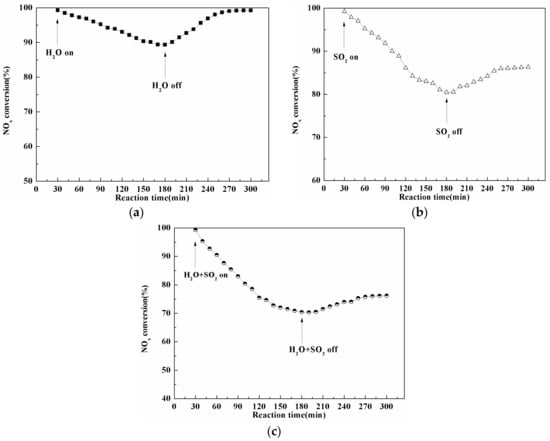
Figure 6.
Effect of (a) H2O, (b) SO2, and (c) H2O+SO2 on NOx conversion over 9%Ce(0.3)–Mn/TiO2–0.8%GO catalyst.
When only 200 ppm SO2 was fed into the reaction system, there was also a decline in the catalytic activity from 99% to a relatively high value of about 82% with time, as shown in Figure 6b. The deactivation of the catalyst caused by SO2 is mainly attributed to the reaction between SO2 and NH3, active components of the catalyst. When the SO2 feeding ceased, the conversion was restored to around 87%. As the addition of Ce can prevent the formation of manganese sulfate on the catalyst surface [22], the 9% Ce(0.3)–Mn/TiO2–0.8%GO catalyst exhibited high resistance to the SO2 pollutants.
When 10 vol % H2O and 200 ppm SO2 were added together into the SCR system, a much more serious decline in the catalytic activity from 99% to about 70% would occur. This meant there was a synergistic effect of the H2O and SO2 on the activation of the catalyst. When H2O and SO2 were removed from the system, the efficiency recovered to around 78%. In order to identify the mechanism of the deactivation of the catalyst caused by H2O and SO2, the FT–IR spectra of GO and TiO2–0.8%GO support, and the fresh and poisoned 9%Ce(0.3)–Mn/TiO2–0.8%GO catalyst were studied, as shown in Figure 7a,b, respectively.
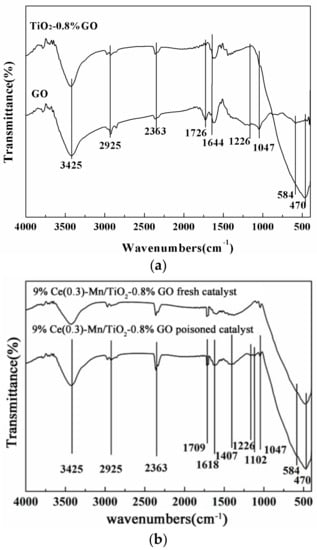
Figure 7.
FT–IR spectra of (a) fresh and poisoned 9%Ce(0.3)–Mn/TiO2–0.8%GO catalyst and (b) GO and TiO2–0.8%GO support.
In Figure 7a, for GO and TiO2–0.8%GO support, the peak at 3425 cm−1 corresponded to the −OH vibrations, and the vibration at 2925 cm−1 was ascribed to the aliphatic stretching vibration of molecule residues of the synthesis. The peaks at 1726 cm−1 and 1644 cm−1 were attributed to the stretching vibration of C=O bond and the C=C stretching of the Csp2 network of GO, while the signals at 1226 cm−1 could be also ascribed to C–N groups originating from the catalyst synthesis [56,57,58]. For the TiO2–0.8%GO support, there was a new peak at 470 cm−1, which was attributed to the stretching vibration of Ti–O.
Compared the FT-IR spectra of the poisoned 9% Ce(0.3)–Mn/TiO2−0.8%GO catalyst with that of fresh catalyst and TiO2–0.8%GO support, it can be found that there was no obvious difference of the appearance of the character peaks. However, it can be found that the band intensity at 3425 cm−1 of the poisoned catalyst was larger than that of fresh catalyst, which indicated the H2O in the flue gas poisoned the catalyst during the SCR reaction process because of the hydrophilic character of GO. It can also be observed that, for the poisoned catalyst, the band intensity of the peak at 1407 cm−1 was higher than that of fresh catalyst and the support. This difference implied the generation of (NH4)2SO4 on the Lewis acid sites. This can also be demonstrated by the analysis of the peak at 1102 cm−1. The peak at 1102 cm−1 corresponded to the existence of SO42−, which can be observed only in the poisoned catalyst. For a large amount of concentrated sulfuric acid used in the synthesis process of GO, some SO42− would be loaded on the surface of GO at the pre-sulfuring step. However, the band intensity at 1102 cm−1 for the poisoned catalyst was only slightly larger than that of fresh catalyst, which indicated the slight poisoning of SO2 to the catalyst. Thus, it can be concluded that for the pre-sulfuring process of GO, serious sulfation of the active component can be prevented and the catalyst exhibited excellent SO2 resistance.
2.4. NH3-TPD Analysis
The surface acidity is an important aspect of the NH3–SCR reaction. By using NH3–TPD analysis, the surface acidity of 9% Mn/TiO2–0.8%GO and 9% Ce(0.3)–Mn/TiO2–0.8%GO catalysts were determined, and the results are presented in Figure 8.
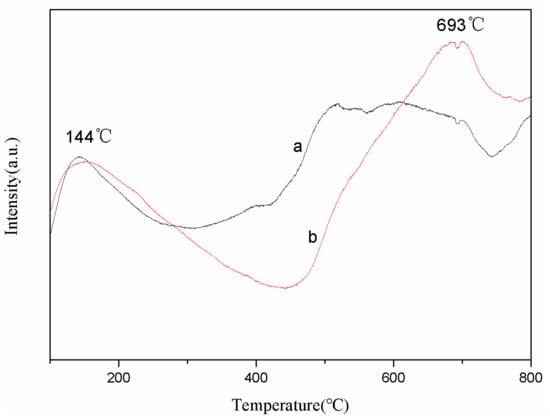
Figure 8.
NH3–TPD patterns of 9% Mn/TiO2–0.8%GO (a) and 9% Ce(0.3)×Mn/TiO2–0.8%GO (b).
For the NH3–TPD pattern of 9% Mn/TiO2–0.8%GO and 9% Ce(0.3)–Mn/TiO2–0.8%GO, there was a strong peak at about 144 °C. For the thermal stability, the NH3 molecules that coordinated to the Lewis acid sites was higher than that of the NH4+ ions bound to the Brønsted acid sites, and the desorption peak at low temperature (below 200 °C) was assigned to NH4+ ions bound to Brønsted acid sites [59]. It was clear that the peak area of 9% Ce(0.3)–Mn/TiO2–0.8%GO was much larger than that of 9% Mn/TiO2–0.8%GO, which indicated that the 9% Ce(0.3)–Mn/TiO2–0.8%GO catalyst provided more Brønsted acidic sites than that of the 9% Mn/TiO2–0.8%GO. Thus, the introduction of CeOx had a significant influence on promoting NH3 adsorption at Brønsted acidic sites. For the 9% Mn/TiO2–0.8%GO catalyst, there was a broad peak in the temperature range of about 450–700 °C, and for 9% Ce(0.3)–Mn/TiO2–0.8%GO there was a peak at about 693 °C. The peaks at high temperature ranging from 400–550 °C were associated with coordinated NH3 molecules originating from the Lewis acid sites, which may originate from the decomposition of nitrite-nitrate species which are formed from the oxidation of ammonia by MnO2 [60]. The desorption peak above 600 °C may be related to the hydroxyl groups on the surface [61]. It has been proven that the Brønsted acid sites also have an important role in the SCR reaction [62], which may be one of the reasons that the SCR reaction activity of 9% Ce(0.3)–Mn/TiO2–0.8%GO was higher than that of 9% Mn/TiO2–0.8%GO.
2.5. H2-TPR Analysis
H2-TPR is a valid method to determine the redox performance of the catalyst. Figure 9 shows the TPR curves of the catalysts. It can be found that the H2-TPR pattern of 9% Mn/TiO2–0.8%GO and 9% Ce(0.3)–Mn/TiO2–0.8%GO was similar, where there was a strong peak at about 446 °C. This peak was attributed to reduction from MnO2 to Mn2O3 [63]. However, it was obvious that the peak area of 9% Ce(0.3)–Mn/TiO2–0.8%GO was much larger than that of 9% Mn/TiO2–0.8%GO, which meant that 9% Ce(0.3)–Mn/TiO2–0.8%GO had larger H2 consumption than that of 9% Mn/TiO2–0.8%GO. Thus, it was demonstrated that 9% Ce(0.3)–Mn/TiO2–0.8%GO had better redox performance than 9% Mn/TiO2–0.8%GO, which was very important for the SCR reaction.
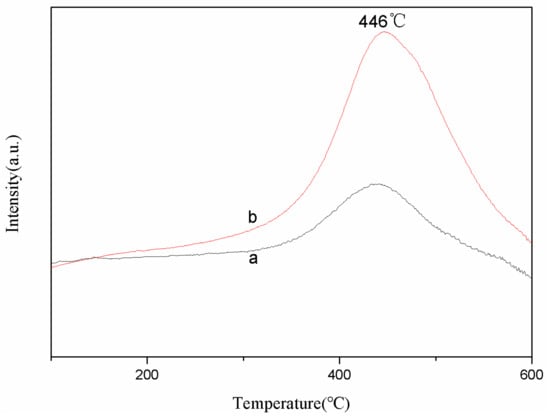
Figure 9.
H2–TPR patterns of 9% Mn/TiO2–0.8%GO (a) and 9% Ce(0.3)–Mn/TiO2–0.8%GO (b).
2.6. Stability Test of the Catalyst
Stability of the 9% Ce(0.3)–Mn/TiO2–0.8%GO catalyst at 180 °C is shown in Figure 10. The NOx conversion slightly decreased during the first 30 h and then reached a stable level of about 94%. The NOx conversion of 94% could last for more than 40 h. Therefore, the 9% Ce(0.3)–Mn/TiO2–0.8%GO catalyst presented good stability and high SCR activity.
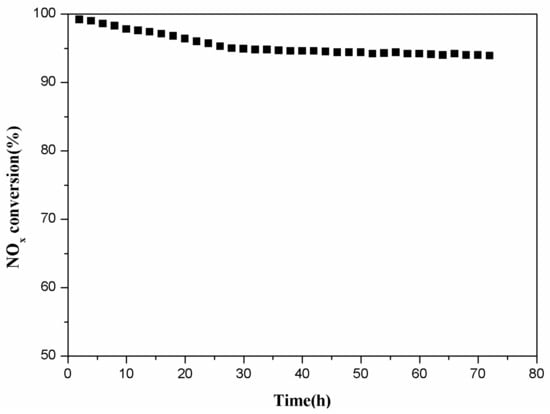
Figure 10.
Stability test of 9% Ce(0.3)–Mn/TiO2–0.8%GO catalyst within 72 h.
3. Materials and Methods
3.1. Synthesis of the Catalyst
Graphene oxide (GO) was synthesized by the modified Hummers method [64]. Firstly, 1 g graphite powder (3000 mesh) and 0.5 g NaNO3 were added into 23 mL of concentrated H2SO4 slowly in a 1000 mL beaker in an ice bath with stirring. After being stirred for 10 min, 3 g KMnO4 was added to the mixture, slowly, and the temperature was kept at 35 ± 3 °C for 30 min. Then a certain amount of H2O2 (30 wt %) and 46 mL of deionized water were added, and the temperature was maintained at 90 °C for 15 min, and warm deionized water was added to a volume of 140 mL. Then the mixture was filtered and washed with 150 mL diluted HCl (10 wt %) and 500 mL of deionized water three times. Then the obtained graphite oxide was dispersed into 500 mL water by ultrasonication at room temperature for 1 h. Unexfoliated graphite oxide in the suspension was removed by subsequent centrifugation at 4000 rpm for 30 min. The graphene oxide was finally dried at 80 °C for 24 h in a vacuum oven.
TiO2–0.8 wt %GO nanocomposites were prepared by the sol-gel method. First, GO was dissolved in a certain amount of deionized water by ultrasonic treatment for 1 h. A certain volume of tetrabutyl titanate and ethanol were stirred to obtain solution A. Glacial acetic acid, GO solution, and anhydrous ethanol were dissolved to obtain solution B. Solution B was slowly dropped into solution A, under vigorous stirring, for 90 min to achieve a uniform brown transparent titanium–GO sol. Brown crystals were obtained after aging of this sol at room temperature for 24 h and then drying at a constant temperature of 80 °C for 12 h to remove the organic solution. Finally, the support was ground, calcined in a tubular furnace in a nitrogen atmosphere, and kept warm at 450 °C for 6 h to obtain the TiO2–0.8%GO powder.
CeOx–MnOx/TiO2–GO catalysts were synthesized with different Mn and Ce loadings totaling 9 wt % by the ultrasonic impregnation method. Manganese acetate and cerium nitrate were chosen as the precursors of the active components. According to the molar ratio of Ce/Mn, certain amount of manganese acetate and cerium nitrate were dissolved in deionized water and added into a breaker containing TiO2–GO. The mixture was sonicated at 60 °C for 90 min to ensure the dispersion of TiO2–GO and full contact of the active components with the support. The samples were air-dried at 80 °C for 12 h and then calcined in a tubular furnace in an atmosphere of nitrogen at 450 °C for 6 h. The fin catalysts were denoted as 9 wt % CeOx(Y)–MnOx/TiO2–GO, where Y represents the molar ratio of Ce/Mn.
3.2. Catalyst Characterization
The morphology of the support of the catalysts was observed by FESEM (Hitachi S–4800, Tokyo, Japan). The HRTEM (FEI Tecnai G2 F20, Hillsboro, OR, USA) was used to observe the morphologies and interplanar crystal spacing of the CeOx–MnOx/TiO2–GO catalysts. The specific surface area, pore volume, and pore size of the samples were determined on a Quadrasorb SI-MP surface area analyzer (Quantachrome Instrument, Boynton Beach, FL, USA) with a nitrogen adsorption-desorption method. XPS (Axis Ultra DLD, Kratos Analytical Ltd., Manchester, UK) was used to analyze the chemical state and surface composition of samples. H2 temperature-programmed reduction (H2–TPR) and NH3 temperature-programmed desorption (NH3–TPD) were performed on a Builder PCA–1200 auto-adsorption apparatus (Builder, Beijing, China). Prior to the H2–TPR experiment, 100 mg of catalysts were pretreated with N2 with a total flow rate of 30 mL·min-1 at 300 °C for 0.5 h, then cooled to room temperature in an N2 atmosphere. Finally, the temperature was raised to 600 °C with a constant heating rate of 10 °C·min−1 in a flow of H2 (5 vol %)/N2 (30 mL·min−1). Prior to the NH3–TPD experiment, the catalysts (50 mg) were pretreated at 300 °C in a flow of N2 (30 mL·min−1) for 0.5 h and cooled to 100 °C under N2 flow. Then the samples were exposed to a flow of NH3 at 100 °C for 1 h, followed by N2 purging for 0.5 h. Finally, the reactor temperature was raised to 800 °C under N2 flow at a constant rate of 10 °C·min−1. The effects of H2O and SO2 were analyzed by a Fourier transform infrared spectrometer (FT–IR PROTÉGÉ 460, Thermo Nicolet, Madison, WI, USA).
3.3. Catalyst Activity Test
Steady-state SCR reaction experiments were performed in a quartz tube fixed-bed continuous flow reactor using 500 mg catalyst of 60–100 mesh. The reactor was placed in an electrically-heated furnace with a programmable controller. The typical reactant gas composition included 500 ppm NO, 500 ppm NH3, 7 vol % O2, 10 vol % H2O (when used), 200 ppm SO2 (when used), with the balance being Ar. The Ar flow gas was divided into two branches. One branch converged with NO, NH3, O2, and SO2 to form the main gas flow, while the other one passed through a heated gas-wash bottle containing deionized water (80 °C) to introduce water vapor into the system when required. The feed flow rate was fixed at 600 mL/min, which was controlled by a mass flow controller and corresponded to a gas hourly space velocity (GHSV) of 67,000 h−1, and the reaction temperature ranged from 80 to 180 °C. At each temperature point, the reaction came to a steady state around 30 min, at which time the experimental data were collected.
NO and NO2 concentrations at the inlet and outlet were monitored by an NOx analyzer (42i–HL, Thermo Scientific Ins., Waltham, MA, USA), while the N2 product was monitored by a gas chromatograph (GC-7890A, Agilent Technologies, Santa Clara, CA, USA). The effluent gas concentrations of N2O was monitored by a Fourier transform infrared spectrometer (FT–IR PROTÉGÉ 460, Thermo Nicolet, Madison, WI, USA).
The NOx removal efficiency and the N2 selectivity were obtained by the following equations:
where , , and correspond to the inlet concentration of NOx, NO, and NH3, respectively. and correspond to the outlet concentration of NOx and NO2, respectively. is the outlet concentration of N2O.
4. Conclusions
In this paper, a series of 9%CeOx–MnOx/TiO2–GO nanocomposites with different molar ratios of Ce/Mn were synthesized by the sol-gel and ultrasonic impregnation methods. The results showed that the TiO2–0.8%GO was an ideal support for the catalyst and several valences of manganese and cerium oxides were uniformly distributed on its surface. MnOx was characterized as MnO, MnO2, Mn2O3, and non-stoichiometric MnOx/Mn, while CeOx was characterized as Ce4+, Ce3+, and Ce2+ in the samples. The coexistence of various valences of cerium and manganese oxide can improve the redox performance of the catalyst. With the addition of Ce, the amount of MnO2 and non-stoichiometric MnOx/Mn, the total oxygen and chemisorbed oxygen content, and the electron transfer ability of the catalyst increased significantly. As a result, the catalyst, with an introduction of Ce in certain amounts, exhibited high catalytic activity and N2 selectivity at low temperature. When the molar of Ce/Mn was kept at 0.3, the 9%Ce(0.3)–Mn/TiO2-0.8%GO catalyst had the highest SCR activity (more than 99% at 180 °C) and reasonable N2 selectivity. The catalyst exhibited good resistance to H2O and SO2. For the presence of hydrophilic groups on the surface of the GO sheets, the competitive adsorption between H2O and NH3 occurred easily, which was considered as the critical factor influencing the H2O resistance of the catalyst. Due to the pre-sulfuring process of GO, serious sulfation of the active component can be prevented and the catalyst exhibited excellent SO2 resistance.
Acknowledgments
The authors gratefully acknowledge the Open Foundation of State Key Laboratory of Advanced Metallurgy under grant KF14-09 and Beijing Municipal Science and Technology Project under grant Z161100002716015 for financial support.
Author Contributions
Zhensong Tong and Xining Lu conceived and designed the experiments; Xining Lu performed the experiments; Zhensong Tong and Xining Lu analyzed the data; Zhensong Tong wrote the paper. Cunyi Song provided manuscript editing.
Conflicts of Interest
The authors declare no conflict of interest.
References
- Kim, C.H.; Qi, G.S.; Dahlberg, K.; Li, W. Strontium-doped perovskites rival platinum catalysts for treating NOx in simulated diesel exhaust. Science 2010, 327, 1624–1627. [Google Scholar] [CrossRef] [PubMed]
- Parks, J.E. Less costly catalysts for controlling engine emissions. Science 2010, 327, 1584–1585. [Google Scholar] [CrossRef] [PubMed]
- Liu, C.; Shi, J.W.; Gao, C.; Niu, C.M. Manganese oxide-based catalysts for low-temperature selective catalytic reduction of NOx with NH3: A review. Appl. Catal. A 2016, 522, 54–69. [Google Scholar] [CrossRef]
- Wang, J.H.; Zhao, H.W.; Haller, G.; Li, Y.D. Recent advances in the selective catalytic reduction of NOx with NH3 on Cu-Chabazite catalysts. Appl. Catal. B 2017, 202, 346–354. [Google Scholar] [CrossRef]
- Kwak, J.H.; Tonkyn, R.G.; Kim, D.H.; Szanyi, J.; Peden, C.H.F. Excellent activity and selectivity of Cu-SSZ-13 in the selective catalytic reduction of NOx with NH3. J. Catal. 2010, 275, 187–190. [Google Scholar] [CrossRef]
- Xu, W.Q.; Yu, Y.B.; Zhang, C.B.; He, H. Selective catalytic reduction of NO by NH3 over a Ce/TiO2 catalyst. Catal. Commun. 2008, 9, 1453–1457. [Google Scholar] [CrossRef]
- Kang, M.; Yeon, T.H.; Park, E.D.; Yie, J.E.; Kim, J.M. Novel MnOx catalysts for NO reduction at low temperature with ammonia. Catal. Lett. 2006, 106, 77–80. [Google Scholar] [CrossRef]
- Kang, M.; Park, E.D.; Kim, J.M.; Yie, J.E. Manganese oxide catalysts for NOx reduction with NH3 at low temperatures. Appl. Catal. A 2007, 327, 261–269. [Google Scholar] [CrossRef]
- Tian, W.; Yang, H.S.; Fan, X.Y.; Zhang, X.B. Catalytic reduction of NOx with NH3 over different-shaped MnO2 at low temperature. J. Hazard. Mater. 2011, 188, 105–109. [Google Scholar] [CrossRef] [PubMed]
- Tang, X.F.; Li, J.H.; Sun, L.A.; Hao, J.M. Origination of N2O from NO reduction by NH3 over beta-MnO2 and alpha-Mn2O3. Appl. Catal. B 2010, 99, 156–162. [Google Scholar] [CrossRef]
- Wu, Z.B.; Jin, R.B.; Liu, Y.; Wang, H.Q. Ceria modified MnOx/TiO2 as a superior catalyst for NO reduction with NH3 at low-temperature. Catal. Commun. 2008, 9, 2217–2220. [Google Scholar] [CrossRef]
- Huang, H.Y.; Yang, R.T. Removal of NO by reversible adsorption on Fe-Mn based transition metal oxides. Langmuir 2001, 17, 4997–5003. [Google Scholar] [CrossRef]
- Lian, Z.H.; Liu, F.D.; He, H.; Shi, X.Y.; Mo, J.S.; Wu, Z.B. Manganese-niobium mixed oxide catalyst for the selective catalytic reduction of NOx with NH3 at low temperatures. Chem. Eng. J. 2014, 250, 390–398. [Google Scholar] [CrossRef]
- Chang, H.Z.; Chen, X.Y.; Li, J.H.; Ma, L.; Wang, C.Z.; Liu, C.X.; Schwank, J.W.; Hao, J.M. Improvement of activity and SO2 tolerance of Sn-modified MnOx-CeO2 catalysts for NH3-SCR at low temperatures. Environ. Sci. Technol. 2013, 47, 5294–5301. [Google Scholar] [CrossRef] [PubMed]
- Zuo, J.L.; Chen, Z.H.; Wang, F.R.; Yu, Y.H.; Wang, L.F.; Li, X.H. Low-temperature selective catalytic reduction of NOx with NH3 over novel Mn-Zr mixed oxide catalysts. Ind. Eng. Chem. Res. 2014, 53, 2647–2655. [Google Scholar] [CrossRef]
- Liu, Z.M.; Yi, Y.; Zhang, S.X.; Zhu, T.L.; Zhu, J.Z.; Wang, J.G. Selective catalytic reduction of NOx with NH3 over Mn-Ce mixed oxide catalyst at low temperatures. Catal. Today 2013, 216, 76–81. [Google Scholar] [CrossRef]
- Wei, Y.J.; Sun, Y.; Su, W.; Liu, J. MnO2 doped CeO2 with tailored 3-D channels exhibits excellent performance for NH3-SCR of NO. RSC Adv. 2015, 5, 26231–26235. [Google Scholar] [CrossRef]
- Jampaiah, D.; Tur, K.M.; Venkataswamy, P.; Ippolito, S.J.; Sabri, Y.M.; Tardio, J.; Bhargava, S.K.; Reddy, B.M. Catalytic oxidation and adsorption of elemental mercury over nanostructured CeO2-MnOx catalyst. RSC Adv. 2015, 5, 30331–30341. [Google Scholar] [CrossRef]
- Wang, Y.L.; Ge, C.Z.; Zhan, L.; Li, C.; Qiao, W.M.; Ling, L.C. MnOx-CeO2/activated carbon honeycomb catalyst for selective catalytic reduction of NO with NH3 at low temperatures. Ind. Eng. Chem. Res. 2012, 51, 11667–11673. [Google Scholar] [CrossRef]
- Qi, G.S.; Yang, R.T.; Chang, R. MnOx-CeO2 mixed oxides prepared by co-precipitation for selective catalytic reduction of NO with NH3 at low temperatures. Appl. Catal. B 2004, 51, 93–106. [Google Scholar] [CrossRef]
- Qi, G.S.; Yang, R.T. Performance and kinetics study for low-temperature SCR of NO with NH3 over MnOx-CeO2 catalyst. J. Catal. 2003, 217, 434–441. [Google Scholar] [CrossRef]
- Jin, R.B.; Liu, Y.; Wang, Y.; Cen, W.L.; Wu, Z.B.; Wang, H.Q.; Weng, X.L. The role of cerium in the improved SO2 tolerance for NO reduction with NH3 over Mn-Ce/TiO2 catalyst at low temperature. Appl. Catal. B 2014, 148, 582–588. [Google Scholar] [CrossRef]
- Wu, Z.B.; Jin, R.B.; Wang, H.Q.; Liu, Y. Effect of ceria doping on SO2 resistance of Mn/TiO2 for selective catalytic reduction of NO with NH3 at low temperature. Catal. Commun. 2009, 10, 935–939. [Google Scholar] [CrossRef]
- Yoshikawa, M.; Yasutake, A.; Mochida, I. Low-temperature selective catalytic reduction of NOx by metal oxides supported on active carbon fibers. Appl Catal. A 1998, 173, 239–245. [Google Scholar] [CrossRef]
- Tang, X.L.; Hao, J.M.; Yi, H.H.; Li, J.H. Low-temperature SCR of NO with NH3 over AC/C supported manganese-based monolithic catalysts. Catal. Today 2007, 126, 406–411. [Google Scholar] [CrossRef]
- Pradhan, B.K.; Sandle, N.K. Effect of different oxidizing agent treatments on the surface properties of activated carbons. Carbon 1999, 37, 1323–1332. [Google Scholar] [CrossRef]
- Solís, T.V.; Marbán, G.; Fuertes, A.B. Low-temperature SCR of NOx with NH3 over carbon-ceramic supported catalysts. Appl. Catal. B 2003, 46, 261–271. [Google Scholar] [CrossRef]
- Liang, Y.Y.; Li, Y.G.; Wang, H.L.; Zhou, J.G.; Wang, J.; Regier, T.; Dai, H.J. Co3O4 nanocrystals on graphene as a synergistic catalyst for oxygen reduction reaction. Nat. Mater. 2011, 10, 780–786. [Google Scholar] [CrossRef] [PubMed]
- Pyun, J. Graphene Oxide as Catalyst: Application of carbon materials beyond nanotechnology. Angew. Chem., Int. Ed. 2011, 50, 46–48. [Google Scholar] [CrossRef] [PubMed]
- Cai, S.X.; Hu, H.; Li, H.R.; Shi, L.Y.; Zhang, D.S. Design of multi-shell Fe2O3@MnOx@CNTs for the selective catalytic reduction of NO with NH3: Improvement of catalytic activity and SO2 tolerance. Nanoscale 2016, 8, 3588–3598. [Google Scholar] [CrossRef] [PubMed]
- Chen, J.H.; Cao, F.F.; Qu, R.Y.; Gao, X.; Cen, K.F. Bimetallic cerium-copper nanoparticles embedded in ordered mesoporous carbons as effective catalysts for the selective catalytic reduction of NO with NH3. J. Colloid. Interface Sci. 2015, 456, 66–75. [Google Scholar] [CrossRef] [PubMed]
- Cao, F.F.; Chen, J.H.; Lyu, C.L.; Ni, M.J.; Gao, X.; Cen, K.F. Synthesis, characterization and catalytic performances of Cu- and Mn-containing ordered mesoporous carbons for the selective catalytic reduction of NO with NH3. Catal. Sci. Technol. 2015, 5, 1267–1279. [Google Scholar] [CrossRef]
- Lerf, A.; Heyong, H.; Forster, M.; Klinowski, J. Structure of graphite oxide revisited. J. Phys. Chem. B 1998, 102, 4477–4482. [Google Scholar] [CrossRef]
- Nie, R.F.; Wang, J.H.; Wang, L.N.; Qin, Y.; Chen, P.; Hou, Z.Y. Platinum supported on reduced graphene oxide as a catalyst for hydrogenation of nitroarenes. Carbon 2012, 50, 586–596. [Google Scholar] [CrossRef]
- Li, D.; Kaner, R.B. Materials science-Graphene-based materials. Science 2008, 320, 1170–1171. [Google Scholar] [CrossRef] [PubMed]
- Scheuermann, G. M.; Rumi, L.; Steurer, P.; Bannwarth, W.; Mulhaupt, R. Palladium nanoparticles on graphite oxide and its functionalized graphene derivatives as highly active catalysts for the Suzuki-Miyaura coupling reaction. J. Am. Chem. Soc. 2009, 131, 8262–8270. [Google Scholar] [CrossRef] [PubMed]
- Park, S.; Ruoff, R.S. Chemical methods for the production of graphenes. Nat. Nanotechnol. 2009, 4, 217–224. [Google Scholar] [CrossRef]
- Gao, Y.J.; Ma, D.; Wang, C.L.; Guan, J.; Bao, X.H. Reduced graphene oxide as a catalyst for hydrogenation of nitrobenzene at room temperature. Catal. Commun. 2011, 47, 2432–2434. [Google Scholar] [CrossRef] [PubMed]
- Zhu, Z.P.; Su, D.S.; Weinberg, G.; Schlogl, R. Supermolecular self-assembly of graphene sheets: Formation of tube-in-tube nanostructures. Nano Lett. 2004, 4, 2255–2259. [Google Scholar] [CrossRef]
- Erickson, K.; Erni, R.; Lee, Z.; Alem, N.; Gannett, W.; Zettl, A. Determination of the local chemical structure of graphene oxide and reduced graphene oxide. Adv. Mater. 2010, 22, 4467–4472. [Google Scholar] [CrossRef] [PubMed]
- Nie, R.F.; Shi, J.J.; Xia, S.X.; Shen, L.; Chen, P.; Hou, Z.Y.; Xiao, F.S. MnO2/graphene oxide: A highly active catalyst for amide synthesis from alcohols and ammonia in aqueous media. J. Mater. Chem. 2012, 22, 18115–18118. [Google Scholar] [CrossRef]
- Su, W.; Lu, X.N.; Jia, S.H.; Wang, J.; Ma, H.Z.; Xing, Y. Catalytic reduction of NOx over TiO2-graphene oxide supported with MnOx at low temperature. Catal. Lett. 2015, 145, 1446–1456. [Google Scholar] [CrossRef]
- Lu, X.N.; Song, C.Y.; Jia, S.H.; Tong, Z.S.; Tang, X.L.; Teng, Y.X. Low-temperature selective catalytic reduction of NOX with NH3 over cerium and manganese oxides supported on TiO2-graphene. Chem. Eng. J. 2015, 260, 776–784. [Google Scholar] [CrossRef]
- Qiu, Y.; Liu, B.; Du, J.; Tang, Q.; Liu, Z.H.; Liu, R.L.; Tao, C.Y. The monolithic cordierite supported V2O5-MoO3/TiO2 catalyst for NH3-SCR. Chem. Eng. J. 2016, 294, 264–272. [Google Scholar] [CrossRef]
- Lu, P.; Li, C.T.; Zeng, G.M.; He, L.J.; Peng, D.L.; Cui, H.F.; Li, S.H.; Zhai, Y.B. Low temperature selective catalytic reduction of NO by activated carbon fiber loading lanthanum oxide and ceria. Appl. Catal. B 2010, 96, 157–161. [Google Scholar] [CrossRef]
- Planeix, J.M.; Coustel, N.; Coq, B.; Brotons, V.; Kumbhar, P.S.; Dutartre, R.; Geneste, P.; Bernier, P.; Ajayan, P.M. Application of carbon nanotubes as supports in heterogeneous catalysis. J. Am. Chem. Soc. 1994, 116, 7935–7936. [Google Scholar] [CrossRef]
- Kapteijn, F.; Singoredjo, L.; Andreini, A.; Moulijin, J.A. Activity and selectivity of pure manganese oxides in the selective catalytic reduction of nitric oxide with ammonia. Appl. Catal. B 1994, 3, 173–189. [Google Scholar] [CrossRef]
- Lee, J.Y.; Hong, S.H.; Cho, S.P.; Hong, S.C. The study of deNOx catalyst in low temperature using nano-sized supports. Curr. Appl. Phys. 2006, 6, 996–1001. [Google Scholar] [CrossRef]
- Chen, Z.H.; Yang, Q.; Li, H.; Li, X.H.; Wang, L.F.; Tsang, S.C. Cr-MnOx mixed-oxide catalysts for selective catalytic reduction of NOx with NH3 at low temperature. J. Catal. 2010, 276, 56–65. [Google Scholar] [CrossRef]
- Fang, C.; Zhang, D.S.; Cai, S.X.; Zhang, L.; Huang, L.; Li, H.R.; Maitarad, P.; Shi, L.Y.; Gao, R.H.; Zhang, J.P. Low-temperature selective catalytic reduction of NO with NH3 over nanoflaky MnOx on carbon nanotubes in situ prepared via a chemical bath deposition route. Nanoscale 2013, 5, 9199–9207. [Google Scholar] [CrossRef] [PubMed]
- Thirupathi, B.; Smirniotis, P.G. Nickel-doped Mn/TiO2 as an efficient catalyst for the low-temperature SCR of NO with NH3: Catalytic evaluation and characterizations. J. Catal. 2012, 288, 74–83. [Google Scholar] [CrossRef]
- Yu, J.; Si, Z.C.; Chen, L.; Wu, X.D.; Weng, D. Selective catalytic reduction of NOx by ammonia over phosphate-containing Ce0.75Zr0.25O2 solids. Appl. Catal. B 2015, 163, 223–232. [Google Scholar] [CrossRef]
- Yang, S.X.; Zhu, W.P.; Jiang, Z.P.; Chen, Z.X.; Wang, J.B. The surface properties and the activities in catalytic wet air oxidation over CeO2-TiO2 catalysts. Appl. Surf. Sci. 2006, 252, 8499–8505. [Google Scholar] [CrossRef]
- Ponce, S.; Pena, M.A.; Fierro, J.L.G. Surface properties and catalytic performance in methane combustion of Sr-substituted lanthanum manganites. Appl. Catal. B 2000, 24, 193–205. [Google Scholar] [CrossRef]
- Xiao, X.; Sheng, Z.Y.; Yang, L.; Dong, F. Low-temperature selective catalytic reduction of NOx with NH3 over a manganese and cerium oxide/graphene composite prepared by a hydrothermal method. Catal. Sci. Technol. 2016, 6, 1507–1514. [Google Scholar] [CrossRef]
- Seifvand, N.; Kowsari, E. TiO2/in-situ reduced GO/functionalized with an IL-Cr complex as a ternary photocatalyst composite for efficient carbon monoxide deterioration from air. Appl. Catal. B 2017, 206, 184–193. [Google Scholar] [CrossRef]
- Omidvar, A.; Jaleh, B.; Nasrollahzadeh, M. Preparation of the GO/Pd nanocomposite and its application for the degradation of organic dyes in water. J. Colloid. Interface Sci. 2017, 496, 44–50. [Google Scholar] [CrossRef] [PubMed]
- Wang, J.H.; Liang, S.; Ma, L.; Ding, S.J.; Yu, X.F.; Zhou, L.; Wang, Q.Q. One-pot synthesis of CdS-reduced graphene oxide 3D composites with enhanced photocatalytic properties. CrystEngComm 2014, 16, 399–405. [Google Scholar] [CrossRef]
- Wang, C.; Sun, L.A.; Cao, Q.Q.; Hu, B.Q.; Huang, Z.W.; Tang, X.F. Surface structure sensitivity of manganese oxides for low-temperature selective catalytic reduction of NO with NH3. Appl. Catal. B 2011, 101, 598–605. [Google Scholar] [CrossRef]
- Wan, Y.P.; Zhao, W.R.; Tang, Y.; Li, L.; Wang, H.J.; Cui, Y.L.; Gu, J.L.; Li, Y.S.; Shi, J.L. Ni-Mn bi-metal oxide catalysts for the low temperature SCR removal of NO with NH3. Appl. Catal. B 2014, 148, 114–122. [Google Scholar] [CrossRef]
- Zhan, S.H.; Zhu, D.D.; Qiu, M.Y.; Yu, H.B.; Li, Y. Highly efficient removal of NO with ordered mesoporous manganese oxide at low temperature. RSC Adv. 2015, 5, 29353–29361. [Google Scholar] [CrossRef]
- Yao, X.J.; Kong, T.T.; Yu, S. H.; Li, L.L.; Yang, F.M.; Dong, L. Influence of different supports on the physicochemical properties and denitration performance of the supported Mn-based catalysts for NH3-SCR at low temperature. Appl. Surf. Sci. 2017, 402, 208–217. [Google Scholar] [CrossRef]
- Deng, J.G.; Zhang, L.; Dai, H.X.; Xia, Y.S.; Jiang, H.Y.; Zhang, H.; He, H. Ultrasound-assisted nanocasting fabrication of ordered mesoporous MnO2 and Co3O4 with high surface areas and polycrystalline walls. J. Phys. Chem. C 2010, 114, 2694–2700. [Google Scholar] [CrossRef]
- Hummers, W.S.; Offerman, R.E. Preparation of graphitic oxide. J. Am. Chem. Soc. 1958, 80, 1339. [Google Scholar] [CrossRef]
© 2017 by the authors. Licensee MDPI, Basel, Switzerland. This article is an open access article distributed under the terms and conditions of the Creative Commons Attribution (CC BY) license (http://creativecommons.org/licenses/by/4.0/).